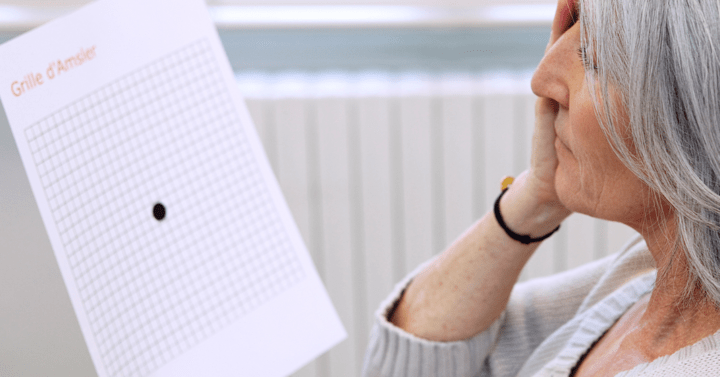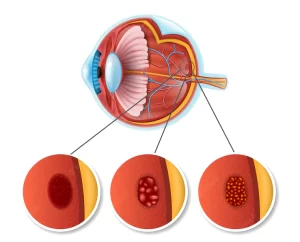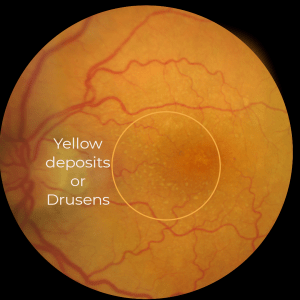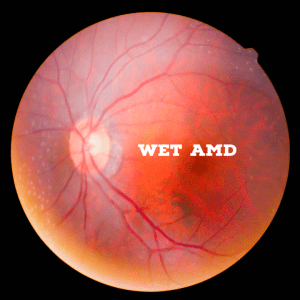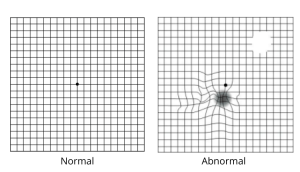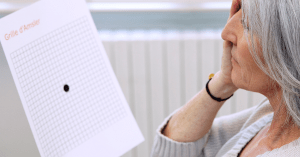Age-related macular degeneration or AMD is seen most commonly among people in the older age group, over 50 years, in which there is damage to the macula or the central part of the retina where a straight-ahead image is formed. Therefore, it leads to central vision loss while the peripheral or side vision remains fine.
This is the third leading cause of blindness worldwide and the first in the developed world, affecting 1 in 7 people.
Types of AMD
Based on the level of progression, there are two types of AMD.
Dry AMD
Dry AMD is an early stage of AMD and is more common.
It is the slow progressive loss of central vision due to a collection of yellow deposits underneath the macula.
These deposits are the waste product of the retina and are known as Drusen.
It is the Drusen that the doctor sees on routine eye examination, enabling him/her to make the diagnosis of AMD.
The important thing to note here is that these drusens will not cause any vision loss and therefore they go unnoticed by the patient.
But it needs to be picked up early and monitored routinely as it can progress to an advanced stage, where there is atrophy or loss of outer cells of the retina, known as geographic atrophy. This can cause severe central vision loss and currently, there is no treatment for this condition.
Some cases may even progress to a more severe form of AMD called Wet AMD.
Wet AMD
Wet AMD is an advanced stage of AMD and is less common than dry AMD.
All cases of wet AMD start as dry AMD. The damage to the macula is because of the abnormal, new blood vessels that start growing underneath the retina.
Due to the fragility of these new vessels, blood and fluid leak between layers of the retina, causing it to raise and resulting in distorted vision.
This can be picked up on routine eye examination. If it’s not treated on time, it can lead to permanent central vision loss.
Signs and symptoms
These are some of the common signs and symptoms associated with AMD.
1. The central vision maybe
- Blurred
- Distorted or wavy
- Having a grey or black spot in the middle of an image
2. Needs assistance with everyday activities like walking
3. Needs bright light to read or write.
Risk factors
Risk factors can be modifiable or non-modifiable.
Non-modifiable risk factors are those that cannot be controlled. These are
1. Family history of AMD
2. Race: most commonly in Caucasians
3. Age: above 50 years
4. Gender: more common in women
Modifiable risk factors are those that can be controlled with changes in behavior or with lifestyle modification.
1. Smoking cigarettes
2. Unhealthy diet with high saturated fat (meat, butter, cheese, etc)
3. Overweight
4. Hypertension (high blood pressure)
5. High cholesterol
6. Heavy sun exposure (UVA and UVB light)
Diagnosis
There are different ways to diagnose this condition and the level of progression, such as
1. Routine eye examination: In addition to your ophthalmologist examining your eyes through a slit-lamp microscope and holding a magnifying lens in front of your eyes, he/she may want you to have your pupils dilated after receiving dilating drops for a comprehensive retinal examination.
2. Amsler grid: It is a simple test that is undertaken in hospitals or can even be used as a home tool that patients can use to monitor disease activity by noticing missing or wavy lines on the Amsler grid.
4. OCT: It is a non-invasive test that uses light rays to take a detailed photo of a cross-section of the macula, where drusens and any inflammatory activity can be seen.
5. FFA or ICG or invasive angiogram of the retina: In this method, a dye is injected into the body, and photos of the inside of the eyes are taken to see the abnormal blood vessels in the retina or bleeding, for confirming the diagnosis of wet AMD.
6. OCT angiogram: It is a non-invasive angiogram of the retina and is currently, the newest equipment in diagnosing wet AMD.
Management
Testing at home
Early diagnosis is the key. Dry AMD progresses slowly and many won’t even notice it in its early stage until tested.
Using the Amsler grid is one of the easiest ways to test yourself at home. To use the Amsler grid,
1. Put your reading glasses on.
2. Keep the Amsler grid at a reading distance or arm’s length.
3. Test one eye at a time while covering the other eye.
4. Look directly at the central dot and notice if any lines or areas in your side vision are looking blurry, wavy, dark, or black.
5. Make a note of what you see.
6. Do this every day.
If you notice any distortion or black spots, consult your doctor immediately.
Treatment
Dry AMD
At present, there is no cure for AMD. We can only halt its progression with proper therapy.
Dry AMD doesn’t require surgical treatment but it does require regular monitoring by annual eye examinations and Amsler grid.
1. Supplements: According to the AREDS2 study, certain supplements reduce the risk of progression to advanced AMD by about 25 percent, although it doesn’t prevent the onset of AMD.
Supplements include
- Vitamin C 500 mg
- Vitamin E 400 IU
- Copper (cupric oxide) 2 mg
- Lutein – 10 mg
- Zeaxanthin – 2 mg
- Zinc 80 mg 80
2. Lifestyle modifications: This is used to help reduce the effect of modifiable risk factors such as
- Including green leafy vegetables in your diet.
- Quit smoking.
- Wearing UV-protected glasses while going out in the sun.
- Controlling BP and cholesterol.
- Doing regular exercises and weight control.
Wet AMD
1. Anti-VEGF:
The abnormal blood vessels growing underneath the retina are caused by an increase in chemicals called VEGF. The doctor will inject anti-VEGF that will block these chemicals and thereby stop the formation of these abnormal leaky blood vessels.
The 4 FDA approved drugs for the treatment of wet AMD are
- Aflibercept (Eylea)
- Bevacizumab (Avastin)
- Ranibizumab (Lucentis)
- Brolucizumab (Beovu)
These injections will need to be repeated every 4-12 weeks, depending on how well the treatment is working. Therefore, monthly follow-ups and OCT are crucial.
2. Susvimo or port delivery system with Ranibizumab:
100 mg/ml of Ranibizumab is delivered as an implant. This is the only FDA-approved therapy for wet AMD that offers as few as two treatments per year.
3. Gene therapy
Currently, it is being tested in clinical trials for assessing the safety and efficacy of long-term gene therapy in the treatment of AMD.
For successful gene therapy, what is important is to select the best therapeutic protein, the vector or vehicle that is going to carry this protein, along with a regulator to control its expression, and the delivery system which decides the route that the vehicle needs to take to deliver the protein.
The protein, which is going to get expressed in the retina chronically, needs to be carefully selected, so that repeated treatment is not required.
Ongoing studies
2. Gene therapy targeting the complement system (an auto-immune mechanism to help fight infection) is being investigated for geographic atrophy seen in the late stages of dry AMD.
This will be given either in a single intraocular injection or by surgical procedure, thereby reducing the burden of frequent injections as with anti-VEGF.
Although gene therapy can bring about a huge change in the treatment of AMD, it is way more complicated, as it’s quite challenging to make the genes stay where they are supposed to and not migrate to other places.
A Brief Summary
AMD is a debilitating eye disease with no cure at present. It affects the central vision and decreases the quality of life. Dry AMD doesn’t require surgical treatment but wet AMD can be financially disabling as the therapy requires monthly injections into the eyes for an indefinite period.
Therefore, it is critical to catch the disease early to avoid severe consequences. A simple home test, such as the Amsler grid, can be of great importance in the treatment of AMD.
If more help is required to understand this topic please feel free to reach out to us.
References:
2. https://www.ncbi.nlm.nih.gov/pmc/articles/PMC3485447/
3. https://pubmed.ncbi.nlm.nih.gov/33197916/
4. https://pubmed.ncbi.nlm.nih.gov/34597713/

